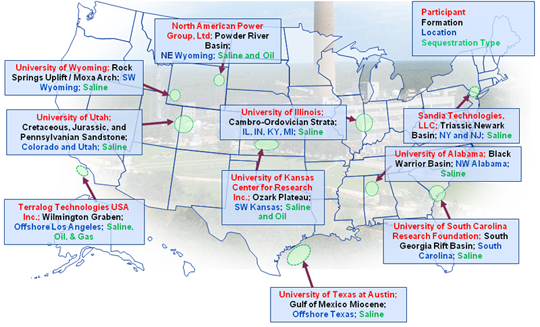
Carbon Storage
ARRA Site Characterization Projects
The National Energy Technology Laboratory (NETL) selected 10 projects that were initially receiving $49 million of DOE funding to characterize promising geologic formations for CO2 storage. The majority of the funding was being provided by the American Recovery and Reinvestment Act of 2009 (ARRA) which was enacted to create new jobs, spur economic activity, and promote long-term economic growth. This research further advances DOE's efforts to develop a national assessment of CO2 storage capacity in deep geologic formations. The 10 projects are providing greater insight into the potential for geologic reservoirs across the United States to safely and permanently store CO2.
An additional $50 million of ARRA funding was provided to augment the work that the existing projects under the Geologic Storage Site Characterization area are performing. This additional funding will allow these projects to better characterize the geology for storage opportunities for industrial CO2 sources. The projects will drill additional and/or deeper wells, collect significantly more core samples, collect additional geophysical samples and data, and conduct more extensive reservoir modeling.
These projects are focusing on the regional site characterization of “high-potential” geologic storage formations. Geologic formation types being evaluated include saline formations, depleting/depleted oil fields (but not specifically or primarily for the purpose of enhanced oil recovery [EOR]), and unmineable coal seams. The formations selected for characterization have adequate seals to protect against adverse impacts on the overlying formations or risks to underground sources of drinking water (USDWs). The projects will develop comprehensive data sets of formation characteristics (porosity, permeability, reservoir architecture, cap rock integrity, etc.) while also developing information and experience to refine best practices for storage site selection and characterization.
While these characterization efforts will increase understanding of the potential for the evaluated geologic formations to safely and permanently store CO2, they also will support the President’s energy goals:
- To develop and deploy near-zero emission coal-based technologies.
- To make the United States a leader on climate change mitigation.
- To transfer carbon capture and storage (CCS) technology globally.
- To reduce U.S. greenhouse gas emissions 80 percent by 2050.
- To increase CCS technology funding.
The 10 awarded projects are summarized below with links to each research efforts' fact sheet:
Participant |
Participant Location |
Project Title |
University of Illinois |
Champaign, IL |
An Evaluation of the Carbon Sequestration Potential of the Cambro-Ordovician Strata of the Illinois and Michigan Basins |
North American Power Group |
Greenwood Village, CO |
Two Elk Energy Park Carbon Site Characterization Project |
Sandia Technologies |
Houston, TX |
Characterization of the Triassic Newark Basin of New York & New Jersey for Geologic Storage of Carbon Dioxide |
South Carolina Research Foundation |
Columbia, SC |
Geologic Characterization of the South Georgia Rift Basin for Source Proximal CO2 Storage |
Terralog Technologies USA |
Arcadia, CA |
Characterization of the Pliocene and Miocene Formations in the Wilmington Graben, Offshore Los Angeles, for Large Scale Geologic Storage of CO2 |
University of Alabama |
Tuscaloosa, AL |
Site Characterization for CO2 Storage from Coal-fired Power Facilities in the Black Warrior Basin of Alabama |
University of Kansas Center for Research |
Lawrence, KS |
Modeling CO2 Sequestration in a Saline Aquifer and Depleted Oil Reservoir to Evaluate Regional CO2 Sequestration Potential of Ozark Plateau Aquifer System, South-Central Kansas |
University of Texas at Austin |
Austin, TX |
Gulf of Mexico Miocene CO2 Site Characterization Mega Transect |
University of Utah |
Salt Lake City, UT |
Characterization of Most Promising Sequestration Formations in the Rocky Mountain Region |
University of Wyoming |
Laramie, WY |
Site Characterization of the Highest-Priority Geologic Formations for CO2 Storage in Wyoming |
Each of these projects will contribute to the knowledge base of best practices for site characterization and approving storage site selection. These projects will support the development of best practices manuals (BMPs) on site characterization for their region and participate in "knowledge sharing" within technical work groups.
On October 5-7, 2010, NETL hosted the Regional Carbon Sequestration Partnership Annual Review Meeting in which the ARRA Site Characterization Projects gave update presentations. Meeting proceedings are available here.


|